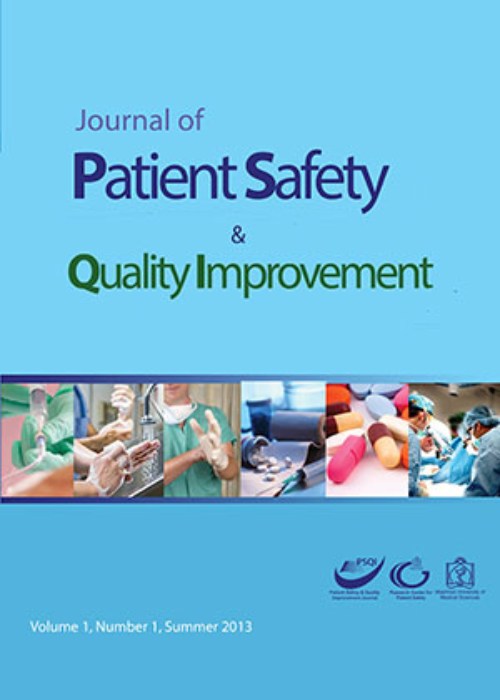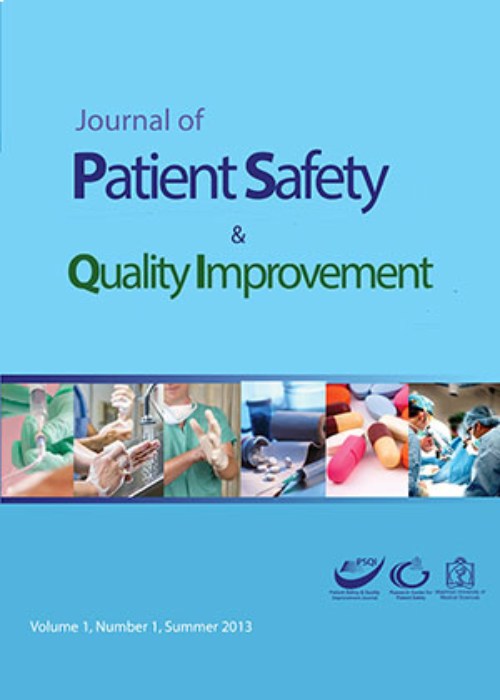فهرست مطالب

Journal Of Patient safety and quality improvement
Volume:11 Issue: 3, Summer 2023
- تاریخ انتشار: 1402/08/15
- تعداد عناوین: 6
-
Pages 145-152IntroductionPatient education is a dynamic and continuous process that starts from the moment of admitting the patient and continues after the discharge. The objective of such education is to empower patients to do self-care and improve their quality of lives. Different methods are available for education. This study was aimed to explore the Facilitators and barriers of remote education using mobile massaging applications.Materials and MethodsThe study was conduct as a participatory action research. Participants were 70 nurses, 14 physicians, and 96 patients. Data was collect with interviews. Data analysis method was content analysis and the research process consisted of four phases of planning, implementing, observing, and reflecting.ResultsThe categories of the Facilitators of mobile learning from physicians, nurses, and patients’ viewpoints were “more accessibility, complete and comprehensive, and ease of virtual education.” Among the barriers were “large volume of content, out of date content that puzzles the users, invalidity of some references, and the risk of infection transmission through mobile phone.” The participants emphasized on the necessity of codifying content, updating educational resources, teaching the methods of using reliable references, and codifying guidelines of disinfecting mobile phones.ConclusionPatient education through remote education in virtual space using massaging applications is an efficient, comprehensive, accessible, and economic method that also brings patients’ satisfaction. It is essential to use experts’ viewpoints to update the references. The patients need to be educated about the right way of disinfecting mobile devices and find reliable references.Keywords: Distance education, Mobile. Self-Care, Patient Education, Virtual Space
-
Pages 153-159IntroductionPatient safety culture is an important aspect for the provision of quality health services, so that it has received attention at the global level, and is the main step in promoting and improving the patient safety culture to evaluate it, for this reason the purpose of this research is to investigation of patient safety culture from the point of view of nurses working in teaching hospitals of Kurdistan University of Medical Sciences in 1401.Materials and MethodsThe present study was descriptive (cross-sectional) and the research sample included 300 nurses working in teaching hospitals of Kurdistan University of Medical Sciences, who were selected for the study by simple random sampling method. The study tool was the patient safety culture monitoring questionnaire in the hospital. Chi-square test was used to compare qualitative variables and independent t-test or its non-parametric equivalent, data analysis was done using Stata 14 software.ResultsThe overall score of patient safety culture dimensions is 140.053 and is in the average range. The dimensions of "information exchange and transfer" with a score of 16.933 is the highest, and the dimensions of "repetition of incident reporting" with a score of 9.9333 is the lowest.ConclusionIt is recommended that measures be taken at different levels, including the ministry and management, to promote patient safety culture, so that hospital managers implement safety culture policies and non-punishment policies in the hospital and support their employees.Keywords: Care, patient, Nursing
-
Pages 161-167IntroductionThis paper proposes an intelligent system for managing medical equipment maintenance in healthcare facilities. The system utilizes machine learning algorithms and data analytics to predict equipment failures, schedule maintenance tasks, and manage spare parts inventory efficiently. The aim is to improve equipment availability and reliability, reduce maintenance costs, and increase patient safety.Materials and MethodsThe proposed system consists of several modules: data collection, preprocessing, equipment failure prediction, maintenance scheduling, spare parts inventory management, and integration. Real-world data is used to evaluate and compare the system's performance with other maintenance management approaches.ResultsThe results demonstrate that the proposed system can accurately predict equipment failures, schedule maintenance tasks efficiently, and manage spare parts inventory effectively. This improves equipment availability and reliability, reduces maintenance costs, and ensures that spare parts are available when needed without incurring excessive inventory costs.ConclusionOverall, the proposed intelligent system for managing medical equipment maintenance is an effective solution for healthcare facilities to optimize maintenance operations, reduce costs, and ensure patient safety.Keywords: Medical E1quipment, Maintenance Management, Intelligent System, Machine Learning
-
Pages 169-174IntroductionAs there is limited research on COVID-19 in children, and reports have indicated low adverse clinical outcomes and mortality rates, our team conducted this study to investigate the clinical outcomes in hospitalized children with COVID-19.Materials and MethodsThis historical cohort study included children aged 1 month to 18 years with COVID-19. They were admitted to a referral hospital in Yazd, Iran, over a year from February 2020. Demographic information such as age and sex, the length of hospitalization, and the reverse transcription-polymerase chain reaction (PCR) test results were recorded. We also evaluated Patients' outcomes, including admission to the pediatric intensive care unit (PICU), need for mechanical ventilation, and mortality.ResultsOur study included 94 patients, of which 52.1% were female and 29.8% were under one year old. Children aged 1-59 months accounted for more than half of the sample (53.2%). The most common symptoms reported were fever (85.1%), respiratory problems (47.9%), and gastrointestinal symptoms (46.8%). The mean duration of hospital stay was 6.4±5.7 days. About 38.3% of cases required admission to the PICU, and 11.7% needed mechanical ventilation. 75% of deaths occurred in children with confirmed COVID-19 who had an underlying disease. Moreover, respiratory distress at the time of referral was significantly associated with admission to the intensive care unit (P=0.008), requiring mechanical ventilation (P=0.003), and mortality (P=0.02).ConclusionOur findings suggest that children under one year old, patients with underlying diseases, and those experiencing respiratory distress at the time of referral are high-risk groups and require special attention in care and treatment.Keywords: COVID-19, Outcome, Hospitalized children, SARS-CoV-2, Iran
-
Pages 175-182Introduction
This paper presents the development of an intelligent system for managing medical oxygen consumption using oximetry and barometry in the hospitals of Mashhad University of Medical Sciences, utilizing machine learning methods. The system integrates various sensors and machine learning algorithms to enable real-time monitoring and control of the oxygen supply chain.
Materials and MethodsThe proposed approach utilizes multiple sensors to measure the purity and pressure of medical oxygen, and this data is collected and processed using machine learning algorithms. The system uses a decision tree model to classify the purity and pressure readings and identify deviations from the specified parameters. The system also utilizes an artificial neural network model to predict future oxygen consumption levels, enabling proactive supply chain management. The system consists of two main components: the hardware component and the software component. The software component includes machine learning algorithms for data processing and system management.
ResultsThe proposed system has been tested in several hospitals affiliated with Mashhad University of Medical Sciences, and the results show that it can effectively monitor and manage medical oxygen consumption with high accuracy and reliability. The machine learning algorithms used in the system have the potential to improve patient safety by identifying potential issues in the oxygen supply chain before they become critical.
ConclusionIn conclusion, this paper presents an innovative and intelligent system that utilizes machine learning methods to enhance the management of medical oxygen consumption in hospitals significantly.
Keywords: Medical Oxygen Consumption, Oximetry, Barometry, Decision tree, Artificial neural network -
Pages 183-188IntroductionThyroid disease is the second endocrine disorder that affects women in reproductive age and its autoimmunity can affect the outcome of the pregnancy. The aim of this study was to investigate the prevalence of Anti-TPO positivity and its effect on pregnancy outcomes in women with unexplained infertility.Materials and MethodsIn this cross-sectional descriptive study, 93 infertile women who referred to infertility center at Ardabil city during 2020-2021 were recruited for the study. Information such as age, BMI, TSH, prolactin and results of Anti-TPO were completed for all cases and then analyzed by statistical methods in SPSS version 23.ResultsThe prevalence of anti-TPO positivity was 73.1% (n=68). The mean of BMI, Age, TSH and prolactin were not significantly different in women with Anti-TPO positivity as compared to others. There was no relation between TSH and Anti-TPO results and Also between TSH and results of pregnancy.ConclusionOur results indicate that anti-TPO screening in pregnancy, may aid in early identification of the women at risk at the future.Keywords: Euthyroid, Pregnancy outcome, Anti-TPO


